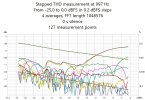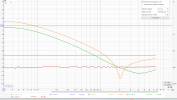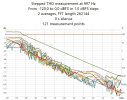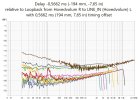I mean, on anything with Intel 13th/14th gen processors it wouldn't be overly surprising, as you want the latest microcode for those (which may still come too late for some 13th gen parts in particular). But that's why I was asking. WD SN580 SSDs also need a firmware update or else they'll fall over with 24H2.
-
Welcome to ASR. There are many reviews of audio hardware and expert members to help answer your questions. Click here to have your audio equipment measured for free!
- Forums
- Audio, Audio, Audio!
- DACs, Streamers, Servers, Players, Audio Interface
- Audio Interfaces (ADC & DAC)
You are using an out of date browser. It may not display this or other websites correctly.
You should upgrade or use an alternative browser.
You should upgrade or use an alternative browser.
Focusrite Scarlett 2i2 (4th Gen) Interface Review
- Thread starter amirm
- Start date
I had the gain knob and the output volume turned to minimum.Input level controls/output level control positions, shorted/non-shorted inputs? SE or differential output? I can give you those values for the two 2i2s here if you clarify the conditions.
I just had a 2i2 Gen 4 come in, so I'll measure to my heart's content.
Tom
It’s a very old HP 8560W from 2012. I bought it broken, chassis was bent, screen broken as well as the keyboard and trackpad. I replaced everything and upgraded the processor with a prototype i7 that finally was not released because it was consuming too much power but the motherboard of that PC would handle it, as well as 32Gb of RAM, that was the reason for the purchase, so I tried. 12 years later, it still runs, and I never thought it would for so long.Crikey, I don't think I've seen one of those pop up in ages (thankfully). Did it seem to point to any component in particular? What kind of hardware did you have again?
Current problem is that one of the two SSD which I setup in Raid0 has an issue. But BSOD seems to have another root cause. I’ll need to investigate or not, since I already bought a new PC.
Odd. @Julian Krause got about 108 dB(A) out of his 3rd gen Solo. Are you sure the copious ultrasonic noise isn't messing with your measurement setup?
Are we talking EIN measurement? I suppose not, right?
Wisdom.Absolutely true. When I was using the two 2i2s (v2 and v3) I have here for measuring, much time was spent trimming input and output levels to find the sweet spot and then not touching the controls.
I discussed with a colleague who owns a professional studio and works freelance, often for the Swiss national television and radio, but his main activity is to record bands from Jazz trio to Hard rock folks, and we had a chat about how to calibrate inputs, headroom, EQ, mixing, mastering, delay, etc… with an interface. It was well spent few hours.
I’d be happy to contribute too! That would also help me double check my measurements are correct. But we indeed need to use the same protocol.Input level controls/output level control positions, shorted/non-shorted inputs? SE or differential output? I can give you those values for the two 2i2s here if you clarify the conditions.
I had a 2i2 gen3 in the past and I was quite happy with it. I’m currently bidding on one, with little luck, it’ll be mine tomorrow. It’ll be great to compare with yours.
I also bought a Clarett+ 4Pre with the intention to review it since it’s never been done here. I hesitated with the Motu at the time, now I’ll be able to compare.
Last edited:
Hmmm... I measured with 20 kHz measurement bandwidth with the AES17 filter enabled. I just read the RMS noise on the APx dashboard.Odd. @Julian Krause got about 108 dB(A) out of his 3rd gen Solo. Are you sure the copious ultrasonic noise isn't messing with your measurement setup?
Are we talking about the same measurement? Noise measured in dB(A) doesn't make much sense. What's the reference?
I did not touch the microphone input. I only used line level I/O.
The spec for the Solo Gen 3 says <0.002 % THD+N (which is -94 dB). Mine meets that spec.
There's no noise spec for the line I/O, but the output supposedly has a 108 dB dynamic range and a maximum output voltage of 15.5 dBu. This would imply that the noise level is -92.5 dBu or 18 µV. That's not too far from the 21 µV (A-weighted) that I measured. Focusrite doesn't specify if the dynamic range is A-weighted or unweighted for the line output, but all the other dynamic range numbers are A-weighted, so I bet this one is too.
Tom
Ah, you were talking noise level, while I was talking dynamic range. So you'd be getting 106.8 dB(A) then, which sounds realistic enough (Amir got similar figures for his 3rd gen 2i2 if memory serves). I am not quite sure why Focusrite couldn't get a bit closer to CS4272 limits (the thing is good for 110-111 dB(A))... I suspect either inadequate ultrasonic filtering (the DAC is a tough nut when it comes to out-of-band noise) or phase noise. The bunch of NJM8065 opamps they're using may not be the last word in voltage noise but neither are they so bad that I would expect them to be a limiting factor.
If the noise level is virtually constant regardless of gain setting, a good hard look at the volume and output stages may be warranted.
Of course, given my luck, it could be something else altogether (e.g. ground noise pollution).
If the noise level is virtually constant regardless of gain setting, a good hard look at the volume and output stages may be warranted.
Of course, given my luck, it could be something else altogether (e.g. ground noise pollution).
I generally don't care as much about dynamic range, which is why I wasn't looking at it that way. I'd rather have low THD and slightly lower dynamic range than high dynamic range and higher THD. Have a look at the Topping E2x2, for example. The output has -100 dBc THD which is mediocre at best, but the dynamic range must be incredible with its noise floor of only a few µV. That's not particularly useful for those of us who are looking to use an audio interface as a cheap audio analyzer, though.
Currently the Scarlett Solo 4 Gen is on sale for $120. MSRP is $150. At that price point I would fully expect Focusrite to have to make many tradeoffs in favour of cost over performance. That likely means crappier opamps. Also, having lower performance for the lower priced products makes sense. It gives buyers of the 2i2 more than just another input.
Tom
Currently the Scarlett Solo 4 Gen is on sale for $120. MSRP is $150. At that price point I would fully expect Focusrite to have to make many tradeoffs in favour of cost over performance. That likely means crappier opamps. Also, having lower performance for the lower priced products makes sense. It gives buyers of the 2i2 more than just another input.
Tom
Wonder if this is a tradeoff we will see in interfaces that is price sensitive.
The AD/DA chips is no longer the limiting parts even in cheap equipment.
According to TI the THD in components will rise in low resistance circuits and the noise will of cource rise in high resistance circuits.
And we clearly see that caps and resistors with much higher distortion than the chips are used in the input/output filters and amps
The AD/DA chips is no longer the limiting parts even in cheap equipment.
According to TI the THD in components will rise in low resistance circuits and the noise will of cource rise in high resistance circuits.
And we clearly see that caps and resistors with much higher distortion than the chips are used in the input/output filters and amps
Distortion caps TI
Cmrr and resistors https://www.ti.com/lit/ab/sboa312/sboa312.pdf
Random older report on smd resistors https://www.waynekirkwood.com/images/pdf/SMT_Resistor_Distortion_rev_1_Dave_Hill_Cranesong.pdf
Cmrr and resistors https://www.ti.com/lit/ab/sboa312/sboa312.pdf
Random older report on smd resistors https://www.waynekirkwood.com/images/pdf/SMT_Resistor_Distortion_rev_1_Dave_Hill_Cranesong.pdf
Last edited:
Have messured quite a bit on Dac with and without output filter. (One with really small size) to me it seems that one indication of passive harmonic distortion is quite big difference on the distortion spectrum before clipping on the diffrent channels. Eg Left and righth. The Dac also distort but way less and more homogenous from channel to channel
bennybbbx
Addicted to Fun and Learning
Of course it does if you have the input gain at max. This is elementary stuff.
It has a 69dB gain range on line inputs and a maximum of 22dBu at maximum attenuation.
when use a test generator which output 0 db, the input gain need set that the input data Level display from ADC in the DAW show -12 db because they write in specs https://focusrite.com/products/scarlett-2i2
- Maximum Output Level16dBu
- Maximum Input Level12dBu
and for the output jacks when output a full sample test signal it is +16 dbu with volume full right. +16 dbu is output value of 4.88 Volt eff
here is online calculator for dbu to volt eff.
dBu in Volt dBV dBu Pegel dBFS digital audio dB Dezibel Umrechnung umrechnen Daempfung Verstaerkung 0 dBFS Bezug Bezugswert Referenzwert Erklaerung absoluter Pegel Logarithmus Verhältnis Dezibel Schalldruck Druck Spannungspegel dBFS dBVU 0 dB Audio S
Umrechnung dB dBu dBFS digital audio dB Dezibel dBV Pegel in Volt zur Tontechnik Erklärung Dämpfung Verstärkung 0 dBFS Logarithmus Bezug Bezugswert Referenzwert absoluter Pegel dBFS SPL Verhältnis Dezibel Spannungspegel Spannung Leistung dBVU dBFS 0 dB Audio Schall mW Rechner pro audio consumer...
One more observation on DAC distortion vs passive distortion.
Be aware that the difference in distortion is huge in these two measurements
First a SMSL SU9 pro into a cosmos ADC-iso 1k input resistance 2.7v
The distortion components in the region goes up and down like a roller coaster

Then a ADAU 1452 combo with cirrus codec 8 ch dac and a distorting output filter.
Two and two outputs on the dac are used as balanced output and put directly into the cosmos ADC-iso.
The highest distortion components have quite smooth rise with input/output level

Lower frequency will make it even more visible. The distortion in one or more caps. Filter on both pos and neg. Probably DC caps

So this is a hint of underdimensioned or "wrong material" distortion in caps. (Maybe also resistors, I don't know)
Be aware that the difference in distortion is huge in these two measurements
First a SMSL SU9 pro into a cosmos ADC-iso 1k input resistance 2.7v
The distortion components in the region goes up and down like a roller coaster
Then a ADAU 1452 combo with cirrus codec 8 ch dac and a distorting output filter.
Two and two outputs on the dac are used as balanced output and put directly into the cosmos ADC-iso.
The highest distortion components have quite smooth rise with input/output level
Lower frequency will make it even more visible. The distortion in one or more caps. Filter on both pos and neg. Probably DC caps
So this is a hint of underdimensioned or "wrong material" distortion in caps. (Maybe also resistors, I don't know)
Here is a ongoing measurement with the cirrus codec with the analog filter stripped away, It now has DC voltage outand no HF analog filter
The roller coaster of the 3rd harmonic is back on display and not shadowed by the analog component smooth distortion

The roller coaster of the 3rd harmonic is back on display and not shadowed by the analog component smooth distortion
Hm, cant blame it all on the caps. Must be some overload on output of dac also. guess 1k is alittle low for this oldish codec
So 3rd harmonic rise towards the end.
With and without filter. -1 and -8 dbFS input. The level goes down 7 dB with the filter so that explain why the dac HF distortion goes down. (Less load on output). But what goes on w filter at 2k for 3rd i don't know


So at high frequency distortion from component in filter or output of dac is more unclear
So 3rd harmonic rise towards the end.
With and without filter. -1 and -8 dbFS input. The level goes down 7 dB with the filter so that explain why the dac HF distortion goes down. (Less load on output). But what goes on w filter at 2k for 3rd i don't know


So at high frequency distortion from component in filter or output of dac is more unclear
Yes, much better for the codec when 10v setting and 3k5 input impedance on ADC-iso
So the distortion hump is there also on this cirrus dac, but under the noise.
So the moral is.


So the distortion hump is there also on this cirrus dac, but under the noise.
So the moral is.
- It's not always better with max out for dacs like for the 2i2
- Beware of component quality on output/input filter at 100+mV signal level. They might render the DAC specs useless like the 2i2 if not outpot volume/impedanse of measurement equipment is considered.
- The ESS hump may lurk under the noise surface even if it is not a ESS dac. (only cademic interest)
- The ADC-iso + REW + long FFT + averages combined are a audio measurement microscope that can indicate if it is DAC, DAC output or filter that distorts the most.


I'd rather have low THD and slightly lower dynamic range than high dynamic range and higher THD.

I think it is possible, but that's two boxes to buy and manage. I haven't checked the prices, but I bet the two combined approach the cost of a QuantAsylum QA403.
Tom
Tom
Similar threads
- Replies
- 3
- Views
- 612
- Replies
- 70
- Views
- 23K
- Replies
- 4
- Views
- 593
- Replies
- 29
- Views
- 10K
